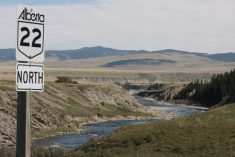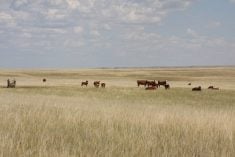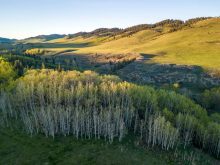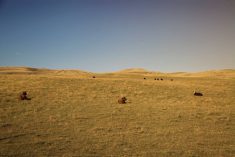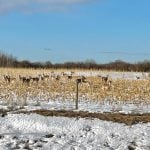A historic southern Alberta ranch is set to become the largest-ever conservation project in Canada.
The McIntyre Ranch, south of Lethbridge, is a 54,000-acre (22,000-hectare) ranch started in 1894 and is one of the largest private landholdings in Canada.
It’s owned by the Thrall family, who are partnering up with Ducks Unlimited Canada (DUC) and the Nature Conservancy of Canada (NCC) to protect it from future development, while remaining a working ranch.
Read Also

Grazing ‘sweet spot’ boosts pasture performance
Timing-focused approach to pasture management touted to boost forage growth, livestock gains while also cutting farmer labour and inputs
Ralph Thrall III, chief executive officer and owner of the McIntyre Ranch, says the agreement will establish a conservation easement on the ranch that will preserve it forever.
“The process has been very rewarding and [this is] a win-win agreement, that will have little impact on how the ranch is operated,” Thrall said.
“Thanks to a landmark agreement between the owners of the ranch, the Thrall family, NCC and Ducks Unlimited Canada — one of the largest tracts of private grassland in North America will be conserved forever,” said Catherine Grenier, president and chief executive officer of The Nature Conservancy of Canada.
The 129-year-old ranch is 40 kilometres south of Lethbridge and covers an area a quarter the size of Calgary. Thrall said it can take 90 minutes to drive it corner-to-corner. It has a unique collection of flora and fauna.

An announcement on the easement was made during an online event June 15. During that meeting, the NCC launched a public campaign to raise the remaining $3 million needed to finish the project. The cost of the total project is not being released.
“The McIntyre Ranch is one of the largest ranches in Alberta and we’ll have the opportunity to conserve it forever,” said Tom Lynch-Staunton, Alberta vice-president with the NCC.
Grenier said less than a third of Alberta’s grassland remains. Up to 70 per cent of wetlands have already been lost in Canada, she said.
The McIntyre ranch has more than 300 wetland basins.
“Because of the intense root system, the grasslands can also protect against fire and drought. They can capture and catch carbon, fighting against climate change,” she said.
“Conserving the McIntyre Ranch pushes back against this loss. It’s a monumental step to stop biodiversity loss.”

Grenier added that the Thrall family’s long-term stewardship over the landscape and their desire to collaborate with the conservation groups made the “once in a lfetime opportunity” possible.
The ranch will be preserved from development in perpetuity once the agreement has come to fruition.
“NCC and DUC have created a stewardship plan, which will help the Thralls reach their goal of making the McIntyre Ranch the most sustainable it can be,” said Lynch-Staunton.
Many organizations have already made financial contributions, including the Alberta Land Stewardship Fund, the Alberta land trust program, and both federal and provincial governments.
Lynch-Staunton called it the largest conservation project in Canadian history.
Another major contributor is the federal government, which has provided more that $4.1 million for the project.
Winnipeg MP Tery Duguid, parliamentary secretary to the minister of environment and climate change, participated in the announcement, noting the government’s support to the Natural Heritage Conservation Program, which is administered by NCC.
“Their commitment to conservation paved the way for this remarkable initiative as well as others across the country,” said Duguid.
NCC says a key part of the project will be demonstrating that ranching and conservation can and do go hand-in-hand.

“The McIntyre Ranch not only holds immense ecological value, but it is also a shining example of western ranching culture and the ranching economy,” said Lynch-Staunton. “We can have both sustainable land stewardship and ranching as well as conservation and biodiversity outcomes. Sustainable grazing has proven once again to be vital to the long-term conservation of grasslands as they evolved with grazing pressure.”
He also noted that the ranch’s owners have built a generations-long tradition of conservation that’s now set to continue in perpetuity.
“The Thrall family have set a shining example for us all,” he said.
However, he also noted that the project is at a “critical juncture” and fundraising needs to be completed to fully fund the undertaking.
“ NCC still needs to raise another $3 million to complete this project,” he said. “We’re creating a call to action to all of you to encourage you to get involved in prairie grassland conservation.”
He noted that could be in the form of individual contributions, corporate sponsorships, and people willing to volunteer with the group.
“Conservation is a collective task and a whole of society approach.” he said. “Together, as we have shown in this remarkable partnership, we have a chance to make a difference on the land that we cherish. And together we can preserve the ranch and protect its own ecological and ranching heritage.”
Lynch-Staunton said the conservation easement ensures the natural wetlands and prairie ecosystem “will never be converted to another use.” But he said that’s just the first step.
“What comes with that is stewardship. With every project we do with a rancher, we also raise a stewardship endowment fund. This supports stewardship on ranches and maintaining the health or helping improve the health of the landscape. This is a long-term partnership, but it still allows ranchers to maintain ranching cattle or other livestock species on the landscape.”
Thrall said the family “is very proud of the collaborative effort between NCC, DUC and our family to establish a conservation easement on the McIntyre Ranch that will conserve it forever.”




